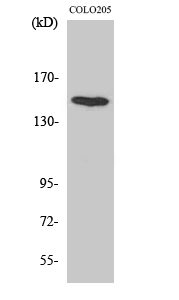MINK1 Polyclonal Antibody
- Catalog No.:YT2764
- Applications:WB;IHC;IF;ELISA
- Reactivity:Human;Mouse
- Target:
- MAP4K6
- Gene Name:
- MINK1
- Protein Name:
- Misshapen-like kinase 1
- Human Gene Id:
- 50488
- Human Swiss Prot No:
- Q8N4C8
- Mouse Gene Id:
- 50932
- Mouse Swiss Prot No:
- Q9JM52
- Immunogen:
- The antiserum was produced against synthesized peptide derived from human MAP4K6. AA range:401-450
- Specificity:
- MINK1 Polyclonal Antibody detects endogenous levels of MINK1 protein.
- Formulation:
- Liquid in PBS containing 50% glycerol, 0.5% BSA and 0.02% sodium azide.
- Source:
- Polyclonal, Rabbit,IgG
- Dilution:
- WB 1:500 - 1:2000. IHC 1:100 - 1:300. ELISA: 1:20000.. IF 1:50-200
- Purification:
- The antibody was affinity-purified from rabbit antiserum by affinity-chromatography using epitope-specific immunogen.
- Concentration:
- 1 mg/ml
- Storage Stability:
- -15°C to -25°C/1 year(Do not lower than -25°C)
- Other Name:
- MINK1;B55;MAP4K6;MINK;YSK2;ZC3;Misshapen-like kinase 1;GCK family kinase MiNK;MAPK/ERK kinase kinase kinase 6;MEK kinase kinase 6;MEKKK 6;Misshapen/NIK-related kinase;Mitogen-activated protein kinase kinase kinase kinase 6
- Observed Band(KD):
- 150kD
- Background:
- This gene encodes a serine/threonine kinase belonging to the germinal center kinase (GCK) family. The protein is structurally similar to the kinases that are related to NIK and may belong to a distinct subfamily of NIK-related kinases within the GCK family. Studies of the mouse homolog indicate an up-regulation of expression in the course of postnatal mouse cerebral development and activation of the cJun N-terminal kinase (JNK) and the p38 pathways. [provided by RefSeq, Mar 2016],
- Function:
- catalytic activity:ATP + a protein = ADP + a phosphoprotein.,cofactor:Magnesium.,function:Serine/threonine kinase that may play a role in the response to environmental stress. Appears to act upstream of the JUN N-terminal pathway. May play a role in the development of the brain.,similarity:Belongs to the protein kinase superfamily.,similarity:Belongs to the protein kinase superfamily. STE Ser/Thr protein kinase family. STE20 subfamily.,similarity:Contains 1 CNH domain.,similarity:Contains 1 protein kinase domain.,tissue specificity:Expressed in the brain, isoform 2 is more abundant than isoform 1.,
- Subcellular Location:
- Cytoplasm . Cell junction, synapse, postsynaptic density . Cell projection, axon . Cell projection, dendrite .; [Isoform 4]: Golgi apparatus.
- Expression:
- Expressed in the brain, isoform 2 is more abundant than isoform 1. Isoform 3 is ubiquitously expressed. Isoform 1 is most abundant in the skeletal muscle. Isoform 4 is ubiquitously expressed with relative high levels in brain, skeletal muscle, pancreas and testis.
- June 19-2018
- WESTERN IMMUNOBLOTTING PROTOCOL
- June 19-2018
- IMMUNOHISTOCHEMISTRY-PARAFFIN PROTOCOL
- June 19-2018
- IMMUNOFLUORESCENCE PROTOCOL
- September 08-2020
- FLOW-CYTOMEYRT-PROTOCOL
- May 20-2022
- Cell-Based ELISA│解您多样本WB检测之困扰
- July 13-2018
- CELL-BASED-ELISA-PROTOCOL-FOR-ACETYL-PROTEIN
- July 13-2018
- CELL-BASED-ELISA-PROTOCOL-FOR-PHOSPHO-PROTEIN
- July 13-2018
- Antibody-FAQs
- Products Images

- Western Blot analysis of various cells using MINK1 Polyclonal Antibody diluted at 1:1000

- Immunohistochemical analysis of paraffin-embedded Human breast cancer. Antibody was diluted at 1:100(4° overnight). High-pressure and temperature Tris-EDTA,pH8.0 was used for antigen retrieval. Negetive contrl (right) obtaned from antibody was pre-absorbed by immunogen peptide.

- Western blot analysis of lysates from COLO cells, using MAP4K6 Antibody. The lane on the right is blocked with the synthesized peptide.



